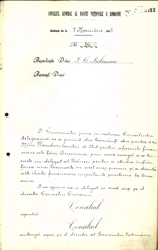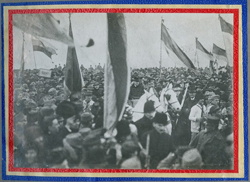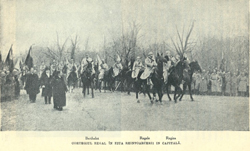Although the year 1918 did not seem to portend well for the Romanians, there was however a first bright spot on 27 March 1918, when Bessarabia proclaimed union with the Kingdom of Romania.

Minutes of the NBR General Board
meeting of 7 November 1918
concerning the situation in Bukovina
(NBR Archives)
The second bright spot of 1918 was the union of Bukovina with Romania. This time as well, the National Bank of Romania was one step ahead the proclamation of the union itself. Specifically, on 7 November 1918, governor Bibicescu informed the NBR General Board of a request from the state secretary for financial affairs in Bukovina that an NBR delegate travel to the capital city of Cernăuţi to look into the matter of establishing a central bank branch there, as well as into other financial matters.
Given the expertise that director Corneliu Cioranu had already acquired in the case of Bessarabia, the General Board designated him to go to Cernăuți as well.

Director Corneliu Cioranu
(NBR Archives photo collection)
On 19 November 1918, after his return from Cernăuți, Corneliu Cioranu communicated the outcome of his visit:
- Decision-makers in Bukovina wanted to see the establishment of an NBR branch in Cernăuți as soon as possible, which Corneliu Cioranu believed to be “a must, both to meet the expectations of the Romanian inhabitants of Bukovina and to support and give counsel to Romanian business ventures which will, no doubt, shortly sprout up”;
- Cioranu had already rented a house in the centre of Cernăuţi to serve as premises for the future branch.
In order to celebrate the 100th anniversary of the union of Bessarabia and Bukovina, and Transylvania, Banat, Crișana and Maramureș respectively with Romania, the National Bank of Romania issued in 2018 collector coins dedicated to these exploits.
Going back to 1918, the Great National Assembly was held in Alba Iulia on 18 November/1 December 1918, after which both the royal family and the key institutions of the Romanian state were to return to Bucharest. The undeniable endeavours of the NBR had also contributed to a Greater Romania.
On 1/14 December 1918, the senior management of the National Bank of Romania held its first meeting back on home turf, in the palace at 25 Lipscani street in Bucharest, which had been commandeered by the German occupation authorities.

One of Samoilă Mârza’s
photographs of the
Great National Assembly in Alba Iulia
The NBR Board Report of February 1919 presented by governor Ioan G. Bibicescu summarised the role played by the central bank during World War One as follows:

The return of King Ferdinand and Queen Maria
to Bucharest (apud Constantin Kirițescu)
“Despite some of the most challenging conditions, we continued our work in Iași, proving to all how much good the National Bank could do, in times that are out of the ordinary and particularly under these exceptional circumstances”.
After the challenges of war, the challenges of peace followed suit. The National Bank of Romania would play a highly complex role in the united territories. The first of the operations that saw the Bank’s involvement was the monetary unification, aimed – in governor Bibicescu’s opinion – at “cementing the idea of state within the new boundaries, forged so heroically by the currency and by our valiant army”.
Hence, during those gruesome years of sacrifice and suffering, but also of reawakening and miracles, the National Bank of Romania fulfilled the mission for which it had been established, by identifying itself with the national destiny.